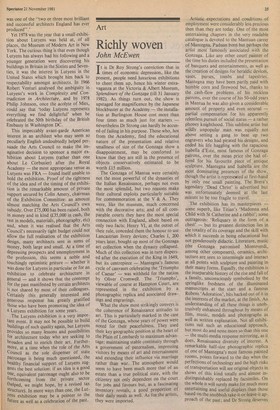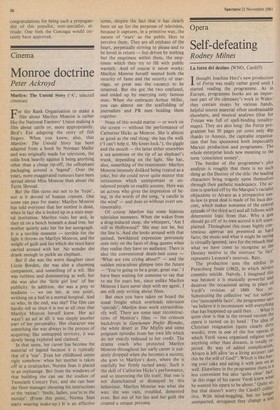Art
Richly woven
John McEwen
T t is Dr Roy Strong's conviction that in times of economic depression, like the present, people need luxurious exhibitions to cheer them up, hence his winter extra vaganza at the Victoria & Albert Museum, Splendours of the Gonzaga (till 31 January 1982). As things turn out, the show is upstaged for magnificence by the Japanese blockbuster at the Academy — the installation at Burlington House cost more than four times as much just for starters — nevertheless Dr Strong can hardly be accused of failing in his purpose. Those who, hot from the Academy, find the educational nature of the presentation and relative smallness of size of the Gonzaga show a disappointment, may be comforted to know that they are still in the presence of objects conservatively estimated to be worth 15 million.
The Gonzaga of Mantua were certainly not the most powerful of the dynasties of the Italian Renaissance, perhaps not even the most splendid, but two reasons make their cultural exploits particularly suitable for commemoration at the V & A. They were, like the museum, much concerned with the decorative arts; and of all comparable courts they have the most special connection with England, albeit based on only two facts: Henry VI, at the outset of their rule, conceded them the honour to use Lancastrian livery devices; Charles I, 200 years later, bought up most of the Gonzaga art collection when the dynasty collapsed. Much of this collection was in turn dispersed after the execution of the King in 1649, but its centrepiece — Mantegna's famous cycle of canvases celebrating the 'Triumphs of Caesar' — was withheld for the nation by Oliver Cromwell. The 'Triumphs', viewable of course at Hampton Court, are represented in the exhibition by a photographic replica and associated drawings and engravings. What the show most strikingly conveys is the coherence of Renaissance attitudes to art. This is particularly marked in the case of the Gonzaga, whose years of power were noted for their peacefulness. They used their key geographic position at the heart of the Plain of Lombardy to maximum advantage: maintaining stable continuity through a government of paternalism, impressing visitors by means of art and entertainment and extending their influence via marriage rather than war. The atmosphere would seem to have been much more that of an estate than a true political state, with the citizenry not only dependent on the court for jobs and favours but, as a fascinating inventory reveals, a good proportion of their daily meals as well. As for the artists, they were imported. Artistic expectations and conditions of employment were considerably less precious then than they are today. One of the most entertaining chapters in the very readable catalogue is devoted to the Mantuan career of Mantegna, Paduan born but perhaps the artist most famously associated with the Gonzaga. Like any other court painter of the time his duties included the presentation of banquets and entertainments, as well as the creation of designs for heraldic devices, vases, purses, tombs and tapestries. Mantegna may have been partly paid with humble corn and firewood but, thanks to the cash-flow problems of his reckless patrons, over the course of his 50-odd years in Mantua he was also given a considerable amount of property and even secured — partial compensation for his apparently relentless pursuit of social status — a rather phoney knighthood. This sublime artist but wildly unpopular man was equally not above setting a gang to beat up two engravers who had pirated his designs, and ended his life haggling with the rapacious Isabella d'Este, most famous of Gonzaga patrons, over the mean price she had offered for his favourite piece of antique sculpture. Mantegna and Isabella are the most dominating presences of the show, though the artist is represented at first-hand by only one small painting. The Brera's legendary 'Dead Christ' is advertised but was unfortunately deemed at the last minute to be too fragile to travel.
The exhibition has its masterpieces — some superb, like Titian's 'Madonna and Child with St Catherine and a rabbit' ; some outrageous: 'Reliquary in the form of a chest' — but its greatest distinction lies in the totality of its coverage and the skill with which it succeeds in being educational but not ponderously didactic. Literature, music (the Gonzaga patronised Monteverdi, among other composers), ceramics, architecture are seen to intermingle and interact at all points with sculpture and painting in their many forms. Equally, the exhibition is the inseparable history of the rise and fall of a family, unconsciously symbolised by the springlike freshness of the illuminated manuscripts at the start and a famous Rubens 'Adoration', bits hacked out of it in the interests of the market, at the finish. An understanding of all these things is unobtrusively enhanced throughout by means of film, music, models and photographs as well as written explanation. Not all exhibitions suit such an educational approach, but most do and none more so than this one — the multi-media response mirroring, as it does, Renaissance diversity of interest. A remarkable half-size photographic replica of one of Mantegna's most famous painted rooms, points forward to the day when the perfections of technology and the high risks of transportation will see original objects in shows of this kind totally and almost indistinguishably replaced by facsimiles. On the whole it will surely make for much more entertaining and useful displays than those based on the snobbish take-it-or-leave-it approach of the past; and Dr Strong deserves congratulations for being such a propagandist of this populist, non-specialist, attitude. One feels the C;onzaga would certainly have approved.











































 Previous page
Previous page